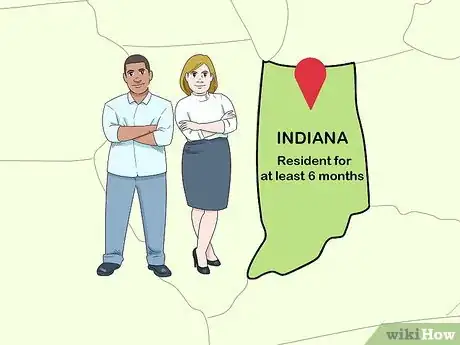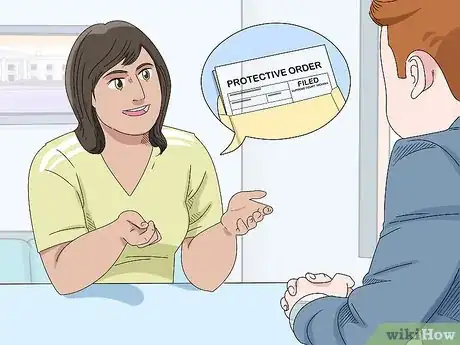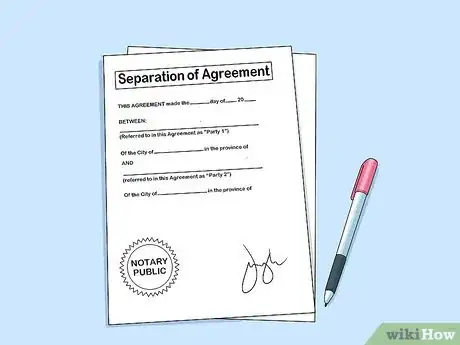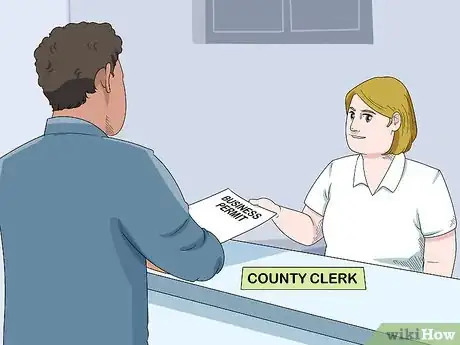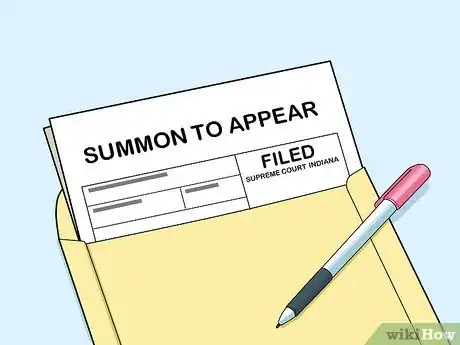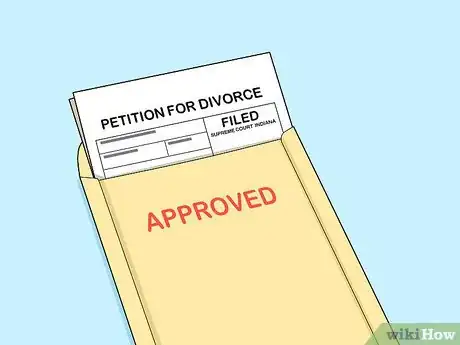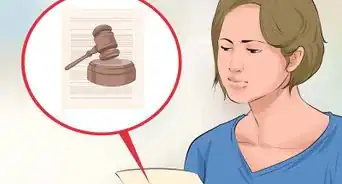This article was co-authored by Valery Cury. Valery Cury is an Immigration Attorney based in Santa Ana, California. With over seven years of experience, she specializes in affirmative cases. Valery earned her Master’s Degree from Brooklyn Law School and her Bachelor’s Degree in Law from Pontificia Universidad Catolica Madre y Maestra in the Dominican Republic. She is licensed to practice in the State of Connecticut. She’s also a member of the American Immigration Lawyers Association (AILA) and the Dominican Bar Association (DBA).
This article has been viewed 22,986 times.
A legal separation is similar to a temporary divorce, where you are still legally married to your spouse but you have legal arrangements around property, child custody, and child support. Filing for legal separation in Indiana can be difficult emotionally but is fairly straightforward legally, requiring you to create a separation agreement, usually with the help of a lawyer, and then filing the agreement with the court. A legal separation lasts for 1 year so you will need to follow up once the agreement expires to determine next steps for you and your spouse.
Steps
Creating the Separation Agreement
-
1Confirm your spouse has not already filed for divorce. If your spouse has already filed for divorce, you cannot file for a legal separation. You will either need to get your spouse to reverse their decision or agree to proceed with the divorce.[1]
- If you do not want to divorce your spouse, you may try to convince them to reverse their filing and agree to a legal separation instead so you can both work on your marriage.
-
2Ensure you or your spouse is a resident of Indiana for at least 6 months. Alternatively, you or your spouse should be a U.S. resident for the 3 months before the petition for legal separation is filed. If this is not the case, you and your spouse may have to wait until 1 of you falls within the timeframe required to file the separation agreement with the court.[2]Advertisement
-
3Work with a lawyer to ensure the separation agreement is accurate. A separation agreement is a complicated document that requires very precise and clear language. Get legal counsel when you draft up the agreement to ensure it is correct and accurate. Hire a lawyer or go to a legal center where you can get professional legal advice and guidance.[3]
- A separation agreement should not take too long to draft with a lawyer, so if you are on a budget, you may try hiring 1 by the hour for guidance and advice.
-
4Include clear reasons why you and your spouse cannot live together. In the agreement, you must provide detailed reasons why you feel want a legal separation from your spouse. You may cite “irreconcilable differences,” “adultery,” “abuse,” or other reasons for the separation.[4]
- In Indiana, there is a no-fault clause for divorces so you do not need to provide detailed reasons to file for divorce. However, you must do so to file a legal separation.
-
5Put in clauses on property ownership in the agreement. Like a divorce agreement, a legal separation should state the division of any property you own jointly with your spouse. There should also be a details about whether you will live in a shared property separate from your spouse during the separation.[5]
- The property ownership details can be reviewed once the legal separation is over if you and your spouse decide to file for divorce.
-
6Ask for temporary maintenance if you have children. Temporary maintenance is when 1 spouse pays money to another during the legal separation to keep up the standard of living for the family. It is a good option if you have children and do not want their quality of life impacted by the legal separation.[6]
- The exact amount of the temporary maintenance will be determined by the court and depend on your spouse’s income as well as their debt, if any.
-
7Include details on child custody and child support. If you and your spouse have children, you should note whether you or your spouse will have full or partial custody of your children during the separation. You may also request that your spouse pay child support on a monthly basis to help provide for your children.[7]
- Work with your lawyer to determine the exact amount of child support you should request in the agreement, especially if you are also requesting full custody of your children during the separation.
-
8Put in a request for a protective order from your spouse, if needed. If you fear for your safety, or the safety of your children, because of your spouse, you can include a protective order in the agreement. The protective order will require your spouse to maintain an exact amount of distance from you and/or your children. It can last for the entire duration of the legal separation to ensure you and your children are protected.[8]
- For a short-term option, you can request a temporary restraining order that requires your spouse to keep their distance for a specific amount of time.
Filing the Petition for Separation
-
1Get the agreement signed and verified by a notary public. Once you have drafted the legal separation agreement, you will need to bring it to a licensed public notary to get it verified. You will also need to take a legal oath to confirm the details in the separation are accurate and true.[9]
- Many public notaries are located close to the country clerk’s office to make the process of filing the petition easier.
-
2File the agreement at the county clerk’s office. Take the signed agreement to the country clerk’s office in your area in Indiana. They will review your documents to confirm you have completed the agreement properly.[10]
-
3Include a summons for your spouse so they know the petition is being filed. As part of the process, you will need to notify your spouse that you are filing a separation agreement using a summons. You will need to provide your spouse’s name, address, phone number, and email address on the summons so an official copy of the petition can be delivered to them.[11]
- You can access a form for filing the summons at the county clerk’s office.
-
4Pay the filing fee. A representative at the county clerk’s office will tell you how much the filing fee is and how you can pay for the filing fee. The fee is usually around $200-$250 USD.[12]
-
5Get the petition approved by the court. Set a court date with your spouse and bring your lawyer with you for legal protection. The court will review your petition and confirm your spouse agrees to it. The judge will then legally approve of the petition and set a start date for the legal separation.[13]
- If your spouse does not agree to the legal separation, you may need to negotiate the terms of the agreement with them. Make sure you have your lawyer present during negotiations to ensure they go smoothly.
Following up on the Legal Separation
-
1Go to counseling during the separation if you want to try to repair the marriage. In some cases, you or your spouse may suggest counseling to help you both work through the issues in your marriage. The judge presiding over your case may also strongly suggest you and your spouse to go to counseling together. However, the judge cannot legally require you and your spouse to attend counseling, especially if you argue that there is violence or serious issues between you and your spouse.[14]
- If you and your spouse want to attend counseling, you can ask your lawyer for recommendations for a good marriage counselor you can go to together.
-
2Keep your distance from your spouse if you plan to file for divorce. If you do not feel you can reconcile with your spouse, you may maintain limited contact with them during the legal separation. In some cases, a legal separation can act as a trial divorce, where you see what it might be like to live apart from your spouse for a prolonged period of time.[15]
- Some couples will use a legal separation as a first step to filing for divorce down the line.
-
3Decide if you want a formal divorce within 1 year. 1 year from the start date of the legal separation, all the agreements and protections noted in the legal separation will end. You and your spouse can then decide if you would like to file for divorce or move back in together and try to work on your marriage.[16]
- You or your spouse can also file for divorce before the 1 year time period for the legal separation is over. In this case, the agreements and protections noted in the legal separation will end and the divorce agreement will take over.
Expert Interview

Thanks for reading our article! If you'd like to learn more about legal separation, check out our in-depth interview with Valery Cury.
References
- ↑ http://www.divorcesource.com/ds/indiana/indiana-legal-separation-5313.shtml
- ↑ https://www.indianalegalservices.org/node/54/legal-separation
- ↑ https://www.indianalegalservices.org/node/54/legal-separation
- ↑ https://www.indianalegalservices.org/node/54/legal-separation
- ↑ https://www.indianalegalservices.org/node/54/legal-separation
- ↑ https://www.indianalegalservices.org/node/54/legal-separation
- ↑ https://www.julieglade.com/blog/legal-separation-vs-divorce-in-indiana/
- ↑ https://www.hg.org/divorce-law-indiana.html
- ↑ https://legalbeagle.com/how-to-file-for-legal-separation-10062.html#how-to-file-for-a-legal-separation-in-indiana
- ↑ https://legalbeagle.com/how-to-file-for-legal-separation-10062.html#how-to-file-for-a-legal-separation-in-indiana
- ↑ https://legalbeagle.com/how-to-file-for-legal-separation-10062.html#how-to-file-for-a-legal-separation-in-indiana
- ↑ https://legalbeagle.com/how-to-file-for-legal-separation-10062.html#how-to-file-for-a-legal-separation-in-indiana
- ↑ http://info.legalzoom.com/file-legal-separation-court-21321.html
- ↑ https://www.indianalegalservices.org/node/54/legal-separation
- ↑ https://www.julieglade.com/blog/legal-separation-vs-divorce-in-indiana/
- ↑ https://www.hg.org/divorce-law-indiana.html

